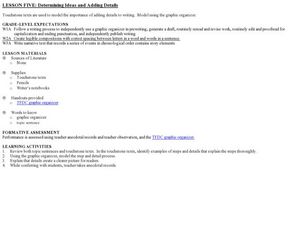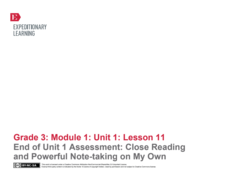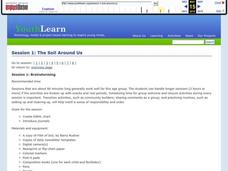Polk Bros Foundation
A Way to Analyze Paragraphs to Figure Out the Main Idea of a Nonfiction Text
Shrink up a section by asking pupils to write down the main idea for each of seven paragraphs. There is a space provided for each main idea. When students have completed this portion, they write down what they think to be the central...
Polk Bros Foundation
Main Idea Analyzer
Show the connection between the main idea and supporting details with a graphic organizer. Pupils fill in the main idea of a text in the circle and the supporting ideas in the boxes connected to the circle.
Curated OER
Why Do Authors Write?
Sixth graders use short reading passages to identify, explain, and discuss the author's purpose for writing. After a lecture/demo, they utilize a graphic organizer embedded in this plan to organize their writing ideas.
DePaul University
Egypt
The country of Egypt is more than just big pyramids and ancient pharaohs. After reading a brief overview of this African nation, young learners will demonstrate their understanding of the text by identifying the main idea and supporting...
Curated OER
Ancient Tales and Legends
Investigate motivational problems using educational software as your students determine details and main ideas of the reading. the class practices sequencing activities and read scary and monster stories, then complete associated...
Curated OER
Analyzing Nonfiction Text Elements - Editorials
Examine the text features of non-fiction. Start the lesson by reading editorial samples provided by their instructor and analyze the texts for word choice, details, and organization. An editorial example and graphic organizer are...
Curated OER
Science Crossword Puzzle
Class members read 25 clues about all areas of science, including biology, chemistry, weather, physical science, and insert their answers into a crossword puzzle. There is no word bank and the learners would need experience with tough...
EngageNY
Continued Close Reading of Bullfrog at Magnolia Circle: Text-Dependent Questions and Vivid Words and Phrases
As 3rd graders continue reading Bullfrog at Magnolia Circle, they focus on the concepts of predator and prey in the fifth lesson plan of this unit. Scholars further develop their ability to answer questions using evidence from the text...
Curated OER
Details, Details, Details
Students add details to their writing. In this language arts lesson, students use details to enhance their writing. Students view a picture and write a paragraph about what they see. Students conference with another student to edit their...
Curated OER
Adding More Details To Sentences
In this writing worksheet, 3rd graders rewrite 4 sentences adding more details to each. They enhance sentences about a field trip, animals, baby animal, and a picnic in the park.
Curated OER
Lesson Five:Determining Ideas and Adding Details
Second graders create their own writing pieces. For this narrative lesson, 2nd graders use a graphic organizer to come up with ideas and details. They practice writing topic sentences.
Curated OER
Detail Tree: Graphic Organizer
In this detail graphic organizer worksheet, students fill in a main topic in the trunk of a tree, then put details in the six clusters of "leaves" on the tree. A reference web site is given for additional activities.
Curated OER
Standards Focus: Recognizing Vivid Details, Of Mice and Men
In this recognizing details worksheet, students read 3 excerpts from chapter 3 of John Steinbeck's Of Mice and Men, underlining each word that evokes some sensory stimulation (sight, sound, smell, touch, taste). Students also respond to...
EngageNY
End of Unit 1 Assessment: Close Reading and Powerful Note-Taking on My Own
As the final lesson plan in a larger beginning-of-the-year unit to establish routines and teach close reading skills, this plan is designed as an assessment piece. Using the story, The Librarian of Basra, learners independently...
EngageNY
Close Reading of Excerpts from My Librarian Is a Camel: How Do People Access Books Around the World?
Acquaint your class with informational text through a close reading. First, examine a couple of pages together, looking at text features and content. The whole class focuses on marking down a brief summary of each paragraph before...
Mr. E. Science
Plate Tectonics
Get a detailed look at plate tectonics with a 14-slide presentation that highlights the Earth's layers, continental drift, seafloor spreading, the theory of plate tectonics, and boundary types. Each slide provides thorough...
School District No. 71
Adding Written Detail: Using Jane Yolen’s Owl Moon as a Mentor Text
Access your senses with a worksheet on sensory language. Based on Owl Moon by Jane Yolen, the worksheet prompts kids to find examples of each of the five senses, as well as phrases for inner emotion.
Curated OER
Key Points
In this graphic organizer worksheet, students fill in the graphic organizer with the key points, details, and summary of a story or topic. Students complete 3 sections.
Curated OER
Details
Third graders write journals, newspapers, and letters with details to enhance their main points. In this details lesson plan, 3rd graders retell an incident with details, create newspaper articles with details, and write letters with...
Curated OER
Hermeneutics: Teaching Students Author's Purpose
Your developing literary critics discuss 'perspective' and discuss how the same occurence can be interpreted by two different people in two different ways. They read Ryszard Kapuscinski's untitled poem, infer meaning of the poem, and...
Curated OER
Reading Connected Text Fluency (Passage)
Practice makes perfect when it comes to reading fluency! Walk your emerging readers through a familiar passage, slowly pointing to each word to keep every learner with you. While looking at a projected passage, scholars read one word at...
Curated OER
Build Mastery: Making Inferences
Do your youngsters realize that they are constantly making inferences? Expose this inner process by bringing out the book they will be reading. Ask scholars what they think the plan is, and explain that their answers are the product of...
Curated OER
Information Shuffle
Gather some information, print it onto sentence strips, and then have your class physically shuffle the cards to better understand the importance of organizational patterns in writing. Middle school learners examine information for a...
Curated OER
"The Soil Around Us" Project
Young geographers collect samples of different kinds of soil to match to the soil terms in Barry Rudner's rhyming book Filet of Soil: dirt, mud, dust, soot, etc. They start a glossary for the project on index cards or large sheets...























